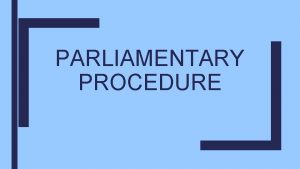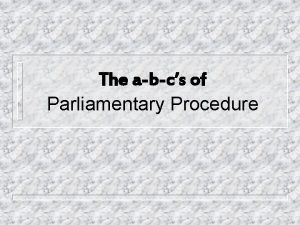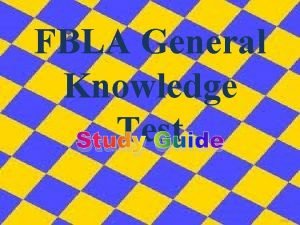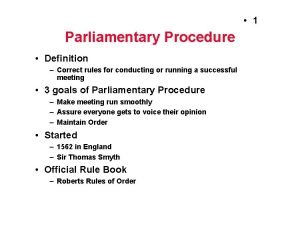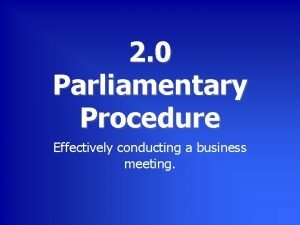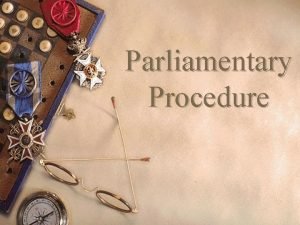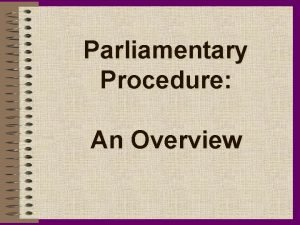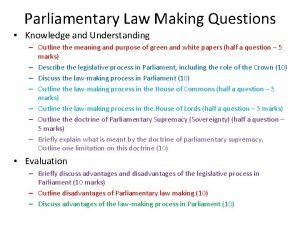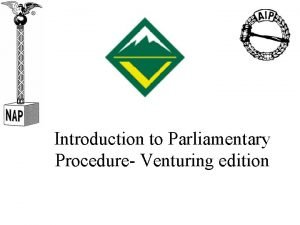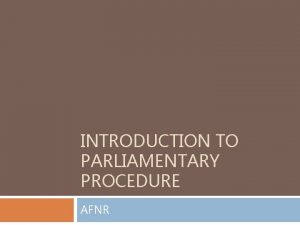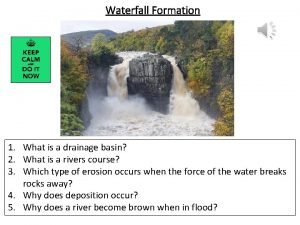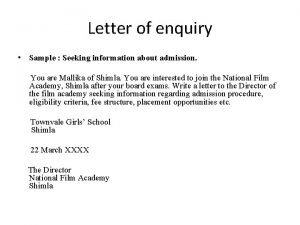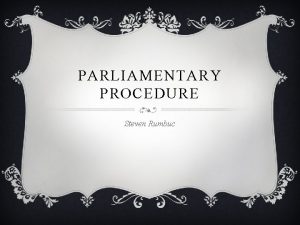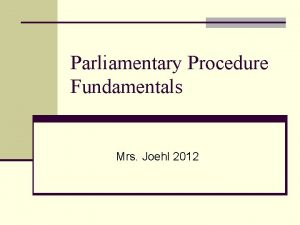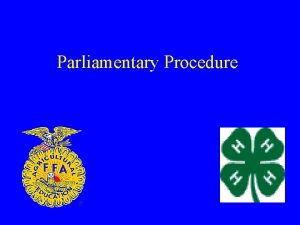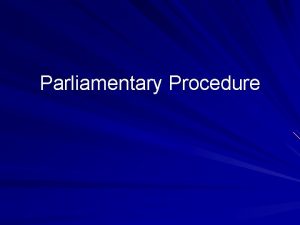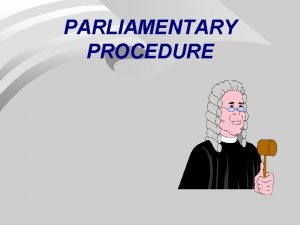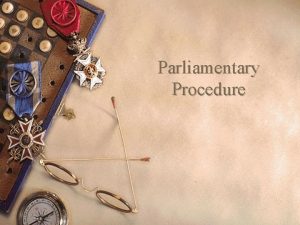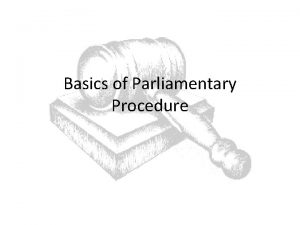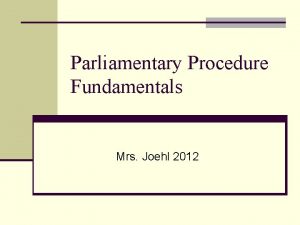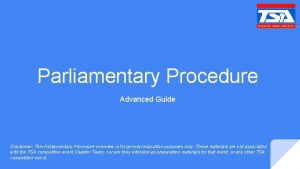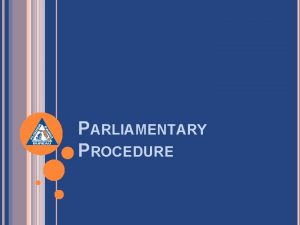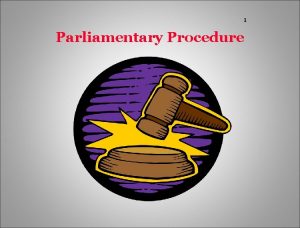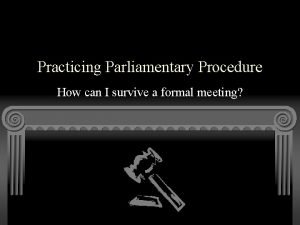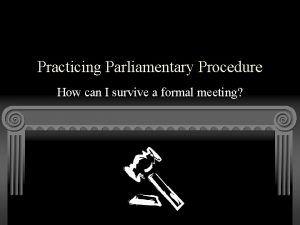Parliamentary Procedure How can I survive a formal






















- Slides: 22

Parliamentary Procedure How can I survive a formal meeting? NOTE: Objectives are rearranged from LADOE for ease of teaching

Objective 1: Define parliamentary procedure. Anticipated Problem: How can parliamentary procedure relate to all business meetings not just FFA? Make a list of many ways that you exercise leadership in your family, school, and community. Explain what works and what does work during a meeting.

Have you ever experienced… q Meetings that seem endless because the business could have been completed hours ago? q Confusion as to what exactly is being discussed and voted on? q Irritation because one person or a small group of people dominate a meeting? q The feeling that you never get your voice heard in group discussion? q Anger about decisions made that do not reflect the feelings of the majority of the group?

End the Frustration!!! Here’s How… v. What is Parliamentary Procedure? v. Why use Parliamentary Procedure? v. The Importance of an Agenda v. The Role of the Members v. Basic Parliamentary Procedure Skills

What is Parliamentary Procedure? Set of rules and guidelines that allow the following: Majority rules Minority is heard Handling one item at a time Maintains order A predetermined set of “rules” that will be used to “govern” the way business will be conducted A system of procedure that allows an organization to effectively conduct its official business in a fair and democratic manner

History of Parliamentary Procedure 1562 – Started in England by Sir Thomas Smyth 1876 – Henry M. Robert finished 1900 – became known as “Robert’s Rules of Order” 2010 – Latest revision

Why use Parliamentary Procedure? ü Focus on one item at a time - no more than one issue will be discussed ü Extend courtesy to everyone - all members have an opportunity to participate ü Observe the rule of the majority - no group decision is granted without majority ü Ensure the rights of the minority - all members have equal access to decision-making

Terminology The Floor point where attention of meeting should be focused. Quorum or Majority Minimum number of members that must be present at a meeting for legal business to be transacted 1/2 of members in a club/organization plus 1

Terminology Presiding Officer referred to as: Mr. /Madam President Mr. /Madam Chairperson An Agenda is a formal listing of the business that is to be conducted at a meeting The agenda must be approved by the membership at the start of the meeting in order to follow it Whenever possible, an agenda should be presented to membership well in advance of the meeting for membership review

Other considerations The taps of the gavel (symbol of leadership, represents chair’s authority). 1 tap: be seated, announce vote. 2 taps: call to order 3 taps: all rise Series of taps: restore order

Other considerations Everyone gets the chance to voice their opinion Everyone gets the chance to Vote Must take yes and no votes Only one topic at a time can be discussed Who ever makes a motion has the right to discuss it first

The Role of Members It is the responsibility of the membership of any organization to establish and maintain effective meeting structure Every member has the right and responsibility to participate in meetings and the process of parliamentary procedure Members must educate themselves regarding the Constitution and By-Laws of the group REMEMBER – Strong group discussion and interaction leads to strong decisions made by the group

Voting on a Motion Can be done by the following means: Voice Hand Raising/Standing/Visual Secret Ballot Roll call Mechanical device

Types of votes Simple majority: one more than half the votes cast; 50% plus one Two-thirds: must have two-thirds of the total population represented to pass; 66. 7% of the vote

Steps to handling a Main Motion Stand Ask to be recognized by President recognizes you by name Motion is correctly stated Motion is seconded Motion is repeated by President Motion is discussed President restates motion Motion is voted on Results of vote announced by President

Anatomy of a Main Motion Always starts with “I move…”

Debating a motion Raise concerns about the motion. Persuade others to vote one way or another. Provide information about motion.

Amending a Motion Allows for changes to a main motion to appease both sides or improve the motion.

Seconding a motion Seconding ensures the following: Get on record as supporting motion. Puts the motion to a vote.

Adjourn Privileged motion that ends current meeting immediately. How many gavel taps to adjourn the meeting? ?

Recess Temporary break in a meeting.

Amend Changes, modifies, or alters a main motion
 All in favor say aye gif
All in favor say aye gif What does hosa stand for
What does hosa stand for Model un parliamentary procedure
Model un parliamentary procedure Abc's of parliamentary procedure
Abc's of parliamentary procedure Fbla knowledge quiz
Fbla knowledge quiz Parliamentary procedure definition
Parliamentary procedure definition Parliamentary procedure at a glance
Parliamentary procedure at a glance Parliamentary procedure hosa
Parliamentary procedure hosa Parliamentary procedure vocabulary
Parliamentary procedure vocabulary Parliamentary procedure definition
Parliamentary procedure definition History of parliamentary procedure
History of parliamentary procedure Parliamentary procedure outline
Parliamentary procedure outline Introduction to parliamentary procedure
Introduction to parliamentary procedure Introduction to parliamentary procedure
Introduction to parliamentary procedure Labelled waterfall
Labelled waterfall How to enquire about admission
How to enquire about admission Did madeleine astor survive the titanic
Did madeleine astor survive the titanic How do adaptations help animals?
How do adaptations help animals? Touching spirit bear chapter 6
Touching spirit bear chapter 6 Berasal dari bahasa apakah survival
Berasal dari bahasa apakah survival Only paranoid survive summary
Only paranoid survive summary Survive
Survive Organisms changed because they wanted to survive
Organisms changed because they wanted to survive

